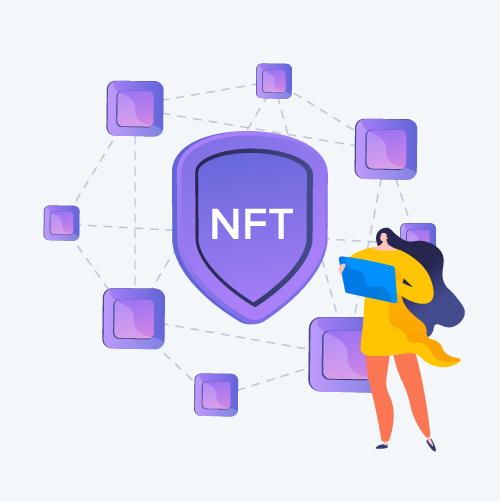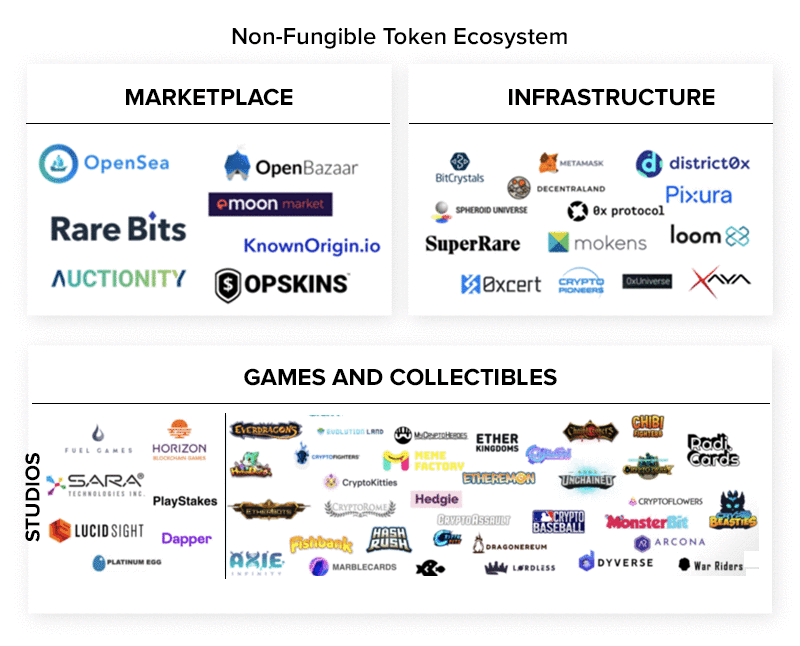What Is NFT And How Does It Works – A Detailed Guide
Being tech-savvy and digitally social-friendly, we share many memes, infographics, jokes, artwork, and other digital assets with our peers and family either for the purpose of entertainment, to gain information, or to make the public aware of some event.
But have you ever wondered, who is the creator of those assets or where is the real origin of that digital property? The answer to these debriefs lies in Non fungible tokens.
It all started in 2017 when the first-ever Non-fungible token was released named Crypto Punks on the American Studio Larva Lab’s Ethereum Blockchain. It was a two-person team back then which consisted of John Watkinson and Matt Hall. In the same year, another project was released named Crypto Kitties that went viral immediately after its arrival. It’s said to generate an investment of a whopping $12.5 million.
In this article, we will dive into non-fungible tokens , what is NFT, how to start non fungible tokens, and how did it start along with its popularity among masses, how to create non fungible tokens, characteristics that make NFT different, its benefits, risks and the upcoming future.
What is NFT
Fungible assets or fungibility denotes an item or an asset that has the ability to trade or get exchanged with a similar type of asset or good, whereas non-fungible assets tokens are unique digital assets whose ownership can be tracked on on NFT blockchain development like Ethereum.
Non-Fungible Tokens aka the NFTs are digital assets or a type of digital certificate for owning goods or an asset that represents a great variety of intangible and tangible items such as paintings, virtual real estate, postcards, videos, and so on. NFTs cannot be replicated or equated with an asset that is similar, because every non fungible tokens asset is unique on its own. You can read more about the development and cost of NFT marketplace here.
To make things more clear to you, let’s take an example of a game ticket. If you give someone a baseball game ticket, then obviously you would take the baseball game ticket. Right? If that someone returns you a movie ticket, will you accept it?
The answer: No, you will not, because a movie ticket will not be as equally valuable as a baseball game ticket. If we place this example in place of NFT, then the game ticket (which is an NFT) cannot be replaced or traded with any ticket, as every baseball game ticket has its own unique identity.
The same is the case with NFT, where you cannot just exchange or trade NFT tokens with similar value tokens, as each token is different from one another and has its own uniqueness and rarity.
Non-fungible Tokens Examples
Owning a digital collectible has its benefits over a physical collectible like a stamp or rare coin. Each NFT consists of distinguishable information that makes it unique from other NFTs and makes the verification of authenticity for a collectible easier.
Like, for an artist, it makes the circulation of fake collectibles useless because the original item can be easily traced back to its legal user. Also, in comparison to other NFT cryptocoins, you can’t exchange NFTs directly with anyone and the reason is the same – they’re all non-identical/dissimilar. For example, if you’ve got two NFCs on a single platform, they still won’t be the same despite being a part of the collection or having the same size and color. Let us see some examples of NFT Projects:
Blockchain Heroes– It is an original trading card series highlighting the similarities between personalities in the crypto and blockchain space.
Decentraland– In this game the players are allowed to buy the virtual world owned by the users. The owner of the virtual space can monetize their world with shops, advertising, etc.
Prospectors.io– It is a blockchain-based game, where the owned assets by the players are given to them in form of blockchain, and players earn NFT based on their gameplay.
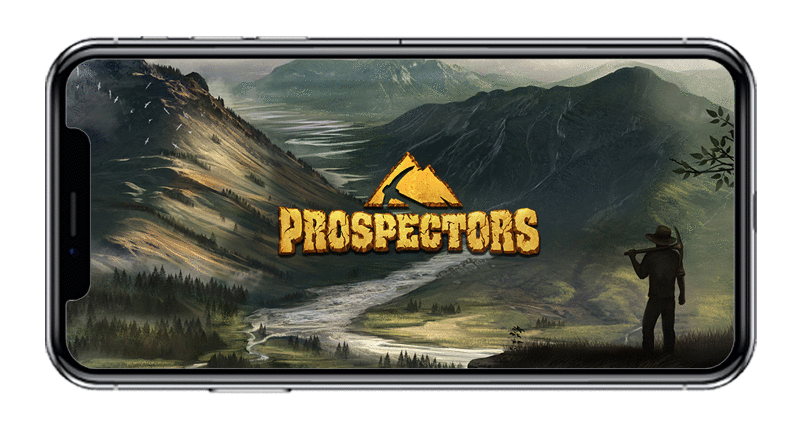
Gods unchained– It is a digital collectible card game or online collectible card game, where the cards are in the form of NFTs that can be freely bought and sold.
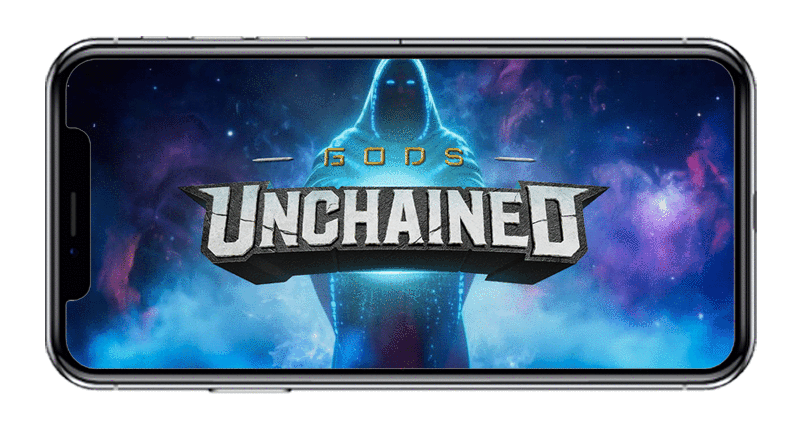
CryptoKitties– It is a famous NFT game that includes breeding and collecting cats. These digital cats took NFTs to the mainstream with each token having distinctive ”cattributes”.
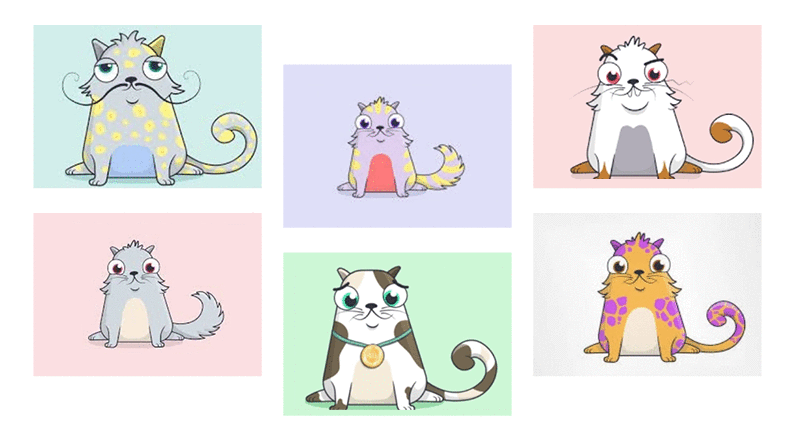
The History of NFT – How and Why Did it Start?
There are some arguments around the first appearance of NFTs. Colored coins are speculated to be the first NFTs to exist. Colored coins are depictions of real-world assets on the blockchain.
The mention of Colored Coins originated from a blog post in early 2012 by Yoni Assia, titled “bitcoin 2.X (aka Colored Bitcoin) — initial specs.” It is said that Colored Coins supported experimentation and laid the groundwork for NFTs.
Then came the trading of Rare Pepes on Ethereum and after this finally the first-ever create NFT Token was released named Crypto Punks.
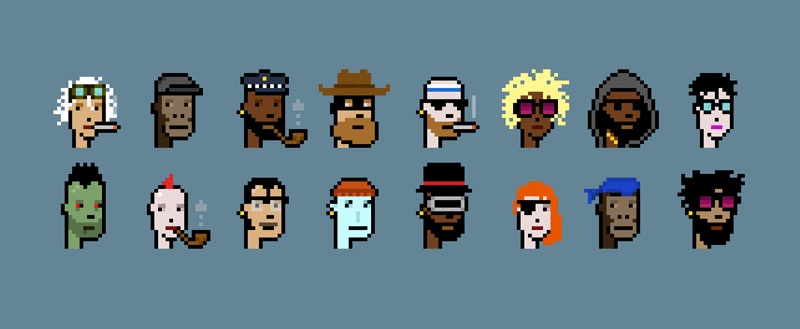
Afterward, a company named Rare Bits emerged as a marketplace and exchange portal for NFTs and raised $6 million in investment. The ideology of NFTs made possible a collectible card game that’s known as Gamedex nowadays and raised more than $800,000 in the initial days itself. Presently, a digital artist in America named Beeple launched his work named “Every day. The First 5000 Days”, which got sold for $69 million (42329.453 ETH). It’s one of the first artworks with NFT to be listed in some of the most important auction houses.
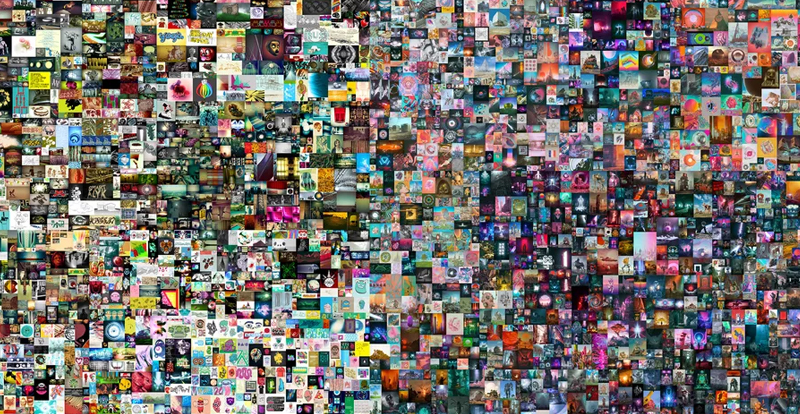
Additionally, in a recent deal, NBA and Dapper Labs launched the beta version of NBA TopShot Collectible and Tradable NFT-based apps in partnership. They’ve been working on this since 2018 and launched it in the first half of 2020. The collectible contains tokens with data and multimedia smashed together in the form of packs.
Reason Behind NFT’s Sudden Popularity
Throughout time, the NFTs are used across numerous industries and today they’re known commonly as Ethereum Tokens based on ERC-721. Several amazing features make NFTs popular these days:
- The complete data of NFT is stored securely in Blockchain which means the tokens can never be removed, destroyed, or replicated no matter what.
- The main source of value for NFTs is their scarcity. Although NFT developers can make an infinite number of tokens, they’re kept limited purposefully to maintain their value.
- NFTs are entirely indivisible which means they can’t be divided like Bitcoins into smaller denominations.
- With the capabilities of Blockchain, NFTs can be easily tracked back to their real owner and eradicates the need for third-party verification forever
*Fun Fact* Bitcoins are completely fungible and can be traded while maintaining a standard value even after the exchange. NFTs cannot be directly exchanged with anyone else unlike regular cryptocurrencies such as Monero, Ethereum, and Bitcoin.
Distant Non Fungible Tokens Characteristics – What Does it Include?
1. Non-Interoperable
As NFTs follow the standard ERC-721, they’re considered to be non-interoperable which means the information stored in them can’t be exchanged or used in any manner.
2. Rare
Presently, the total number of NFTs is very less in the world and they’re very scarce. This not only makes them rare but also makes their value high. In simple terms, the lesser the number of NFs, the pricier they’ll be.
3. Indestructible
The NFTs are stored and managed through Blockchain that results in a greater level of security for them. This means they can never be destroyed or removed at any cost.
4. Indivisible
You can’t send a portion of NFT cryptocoins to anyone (unlike other cryptocurrencies) because they’re non-fungible and don’t have a defined value. For instance, one bitcoin will possess the same value after transfer but NFT won’t.
5. Unique
Resonating with real artwork, NFTs use blockchain to stay apart from the crowd and determine the authenticity of a state of art. It also allows you to distinguish original items from their replicated copies.
The Working Methodology of NFTs
NFTs are unique crypto tokens that are managed on a blockchain. Thus, blockchain acts as the decentralized ledger that traces the ownership and transaction history of each NFT, which has a code and a unique ID, and other metadata that no other token can duplicate.
How do non fungible tokens work? To answer this, let’s read below:
The process of creating NFTs can be done through contract-enabled blockchains with the help of appropriate tools and support. Ethereum was one of the first widely used EOS, NEO, and now it also includes NFT standards. The tokens along with their smart contracts allow adding detailed information such as the owner’s identity and so on.
This process provides NFTs the attributes of scarcity and royalties that make it attractive when coupled with digital media:
Scarcity
When we talk about scarcity, we mean that the owner gets to decide the scarcity of their assets. For example, if we take an example of a ticket to any sporting event or a concert, then there the owner decides how many tickets to be sold. Same way in NFT token market, the creator can decide how many replicas should be there. So these replicas are there with a slight difference to each one of them.
In another example of how to create non fungible tokens, the owner can create NFT token only one, making it a special rare collectible. In any case, each of the NFT will have its own unique identity, such as a bar code on every cloth or ticket that looks similar to each other but is uniquely different.
Royalties
NFTs are coded with software code (called smart contracts) that governs the prospects such as verifying the ownership and managing the transferability of the NFTs. Also, NFTs can get programmed beyond the basics of ownership and transferability like any software application that incorporates a variety of applications and functionality (which also involves the linking of NFT to other digital assets).
For example, a smart contract could be created in such a way that some NFTs automatically allocate a share of the amount paid for any sale of the NFT, that is pay the royalties to the original owner.
When somebody creates an NFT, they are composing the smart agreement code that administers the Non fungible tokens characteristics, which are added to the blockchain where the NFT is managed. Numerous blockchains can be used to handle NFTs, including Ethereum (with its established ERC-721 and ERC-1155 smart contract principles), Flowchain, and Wax, all of which make use of similar processes. Prominently, certain NFT marketplaces function with certain blockchains, thus the choice of blockchain to be used for NFT can have real implications for the seller, if not taken proper decisions.
Non-fungible Tokens Use Cases Across Multiple Industries
1. Gaming
Majority of the games have their virtual currency within their ecosystem that helps users make their progress easier. With that said, accounts with numerous purchased commodities have a great demand in an ever-expanding unregulated market. The different uses of NFTs will allow players to easily trade in-game collectibles with proper validation and security.
2. Digital Assets
For digital assets like house plans, mock-ups, themes, and domains, NFTs are certainly a perfect match. Moreover, digital real estate in games like Decentral Land is getting popular these days. They allow players to purchase and develop a set of spaces in a virtual world. The addition of NFT can make sure original creators can be traced back to these items.
3. Identity Theft
The things that represent identity and can be digitized such as medical records and academic qualifications can make use of NFTs to prevent identity theft. Furthermore, the importance of non-fungible tokens help can be noticed with digital artists able to use it to convert their artworks and establish unique copyright for them. It also helps in separating counterfeits from the original.
4. Digital Collectibles
It’s a no-brainer that NFTs are rare and they find their major use in collectibles and art. With the addition of this token, the authenticity and ownership of a collectible or artwork can be easily verified. This also allows an artist to prevent their work from being misappropriated or pirated. NFT has already started to be used in cards and merchandise.
5. Identification and Certification
NFTs contain a unique set of information about an asset or a good programmed into them. This makes them a perfect match for issuing certificates, identities, qualifications, and licenses. The identification or certification can be issued directly through the blockchain as an NFT to make it traceable back to the source.
When the concepts of NFT are clear, we can clearly see the benefits of a blockchain of smart contracts that become a potent force for change.
Non-fungible Tokens Benefits
Ownership Rights
Advantages of non-fungible tokens can be utilized to address something extraordinary, both in the digital world and in reality. This has been utilized for collectibles and gaming in the digital world (demonstrating someone claims a particular CryptoKitty or item), yet it could similarly be applied to unique items in the real world – like houses, vehicles, craftsmanship, or potentially even personalities. It could likewise be utilized to allow specific access, giving access to Airbnb at specific occasions or for air travel tickets.
Customization Approach
Advantages of Non-fungible tokens are safe unlike other tokens that can’t be. Smart agreements/contracts and fungible tokens could possibly enact a portion of the functions of non-fungible tokens. However, in the non-fungible token market, all the information is held by the token itself.
The token can have additional information allocated to it which could incorporate standard options like the name and the ownership, but could be extended to areas like the history of the token and related data – an image of the house the token represents, the previous owners of a vehicle the token represents, or the count of character skins in a game with a similar model type the token represents.
Secure Trade
Generally, importance of non-fungible tokens can be seen with transferring the ownership of physical or digital items is at risk of fraud, and as such is either difficult in its execution or sometimes it is basically not permitted. With the security of blockchain and the uniqueness of non-fungible tokens, exchanging anything addressed by the token would be a much less complex and more effective process. As a token, it might actually permit the responsibility of ownership of items to be transferred across platforms or even be interoperable across various services like games or NFT marketplaces.
There is a mixed bag of characteristics when it comes to the characteristics of NFT. With every benefit there are risks that have to be taken into account to prove it.
Risks Associated With NFT
Valuations
If you are thinking of how to buy NFT? Then you should know that purchasing an NFT, similar to any collectible is a risky bet with its value going up. Unlike Blockchain asset tokenization trading cards or buying a real asset, NFTs are an up-and-coming market so there is no guarantee that there is going to be a similar kind of demand on digital assets.
If there is no demand for the NFT you buy, you could end up paying an enormous sum for something that decreases in value or is simply un-sellable. You could also make your own NFT however there is no assurance of a buyer which could lead you to waste your time and money.
Storage
Sales in NFT are recorded through blockchain technology, which demonstrates ownership. The real NFTs are made and stored through marketplaces and platforms like Open Sea or Rarible.
If by any chance these platforms get shut, there will be no assurance that you would have the option to access the work. This makes it less secure than having a physical art hanging on a wall or gaming tickets or trading cards that won’t just simply vanish.
Regulation
There is no regulation of NFTs so there is a lot of trust required. You need to believe that the NFT you are purchasing is a unique piece of art or work and hasn’t been replicated from somewhere else or you could face a copyright issue.
Also, if regulators and administrators get concerned regarding this thriving business, then there could be crackdowns on platforms and limitations on how much collectors can contribute. This could lead to decreasing the NFT token market value.
Hot Potato Effect
NFT games can have a ”hot potato” effect. Meaning that the players buy an asset to sell it for a profit, but if the market collapses, it can lead to a huge loss.
For example, you have a gaming sword and you are longing to sell it for a higher price than it was previously. Now the thing is, as long as someone is willing to buy, you will make a profit, but if there is no one to purchase the non fungible asset or if the market collapses, then you are at loss.
Future of NFTs
Whatever the risks, the future looks promising for NFTs as the total market for them crossed a whopping $100 million by the end of July 2020. Experts in the crypto industry even speculate that 40% of new crypto users will use NFTs as an entry point.
With the decentralized finance industry surpassing $4 billion in value, it is evident that the NFT space is set to grow exponentially in the days to come.
FAQ’s Regarding NFT
O1. What is NFT crypto?
Ans. Non-Fungible Tokens aka the NFTs are digital assets or a type of digital certificate for owning goods or an asset that represents a great variety of intangible and tangible items such as paintings, virtual real estate, postcards, videos, and so on.
Q2. Where to buy NFT?
Ans. You can shop for them online through various marketplaces. OpenSea is a big one. Think of it as an online gallery where you can browse digital art, trading cards and other collectibles.
Q3. How to invest in NFT?
Ans. If you’re interested in investing in NFT, then you’ll need a cryptocurrency like Ethereum (ETH) or a Bitcoin. Once the cryptocurrency is in your wallet, from there on you can search sites like Rarible or SuperRare to get or buy the best digital artwork.
Q4. What is an NFT art?
Ans. NFT art is any type of digital file such as an artwork, an article, music or a meme.
The Takeaway
You may have already figured out that it’s still in its early stage of development. Therefore, you can easily expect numerous cutting-edge platforms based on NFTs in the coming years.
Talking about the present, it’s transitioning from Crypto Kitties and gaming to digital identity, painting, and other non fungible tokens use cases. This means that the market is still raw in terms of experimentation. For a new-age entrepreneur, this would mean a sea-full of opportunities to enter and rule the space blockchain development services sector. We are here to help. Share your NFT-based project idea with us.

strategies your digital product..
